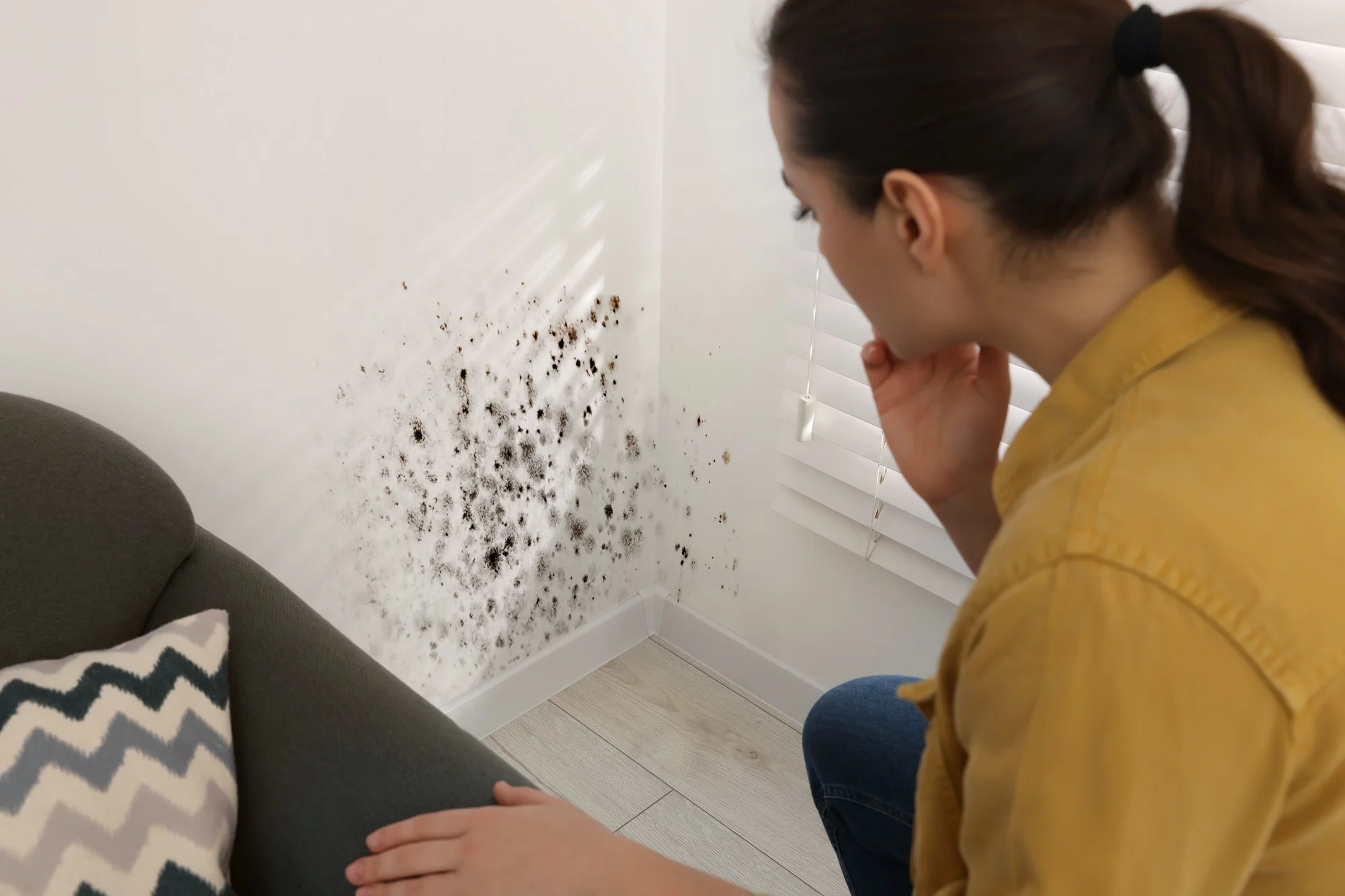
12 Different Types of Mold in Homes and Easy Prevention Strategies
Mold spores are all around us every day, in the air we breathe and even in the wind that blows into our interior spaces. In the natural world, mold spores play an important part in breaking down natural matter; however, when they get inside homes and form colonies, they not only look unsightly but also pose health risks.
Most people want to know what type of mold is dangerous in a house. While mold exposure is rarely fatal, the U.S. EPA states that all mold species may pose health risks. That’s why prompt mold cleanup is critical — no type should be left untreated for long.
Alongside tips for mold cleanup, EuroMaids offers a helpful visual guide for mold identification. Still unsure? Book a professional one-time cleaning in Naperville. Avoid touching mold directly — always wear gloves, goggles, and a mask, as inhaled spores can impact respiratory health.
Understanding the 12 Main Types of Mold That Grow Indoors
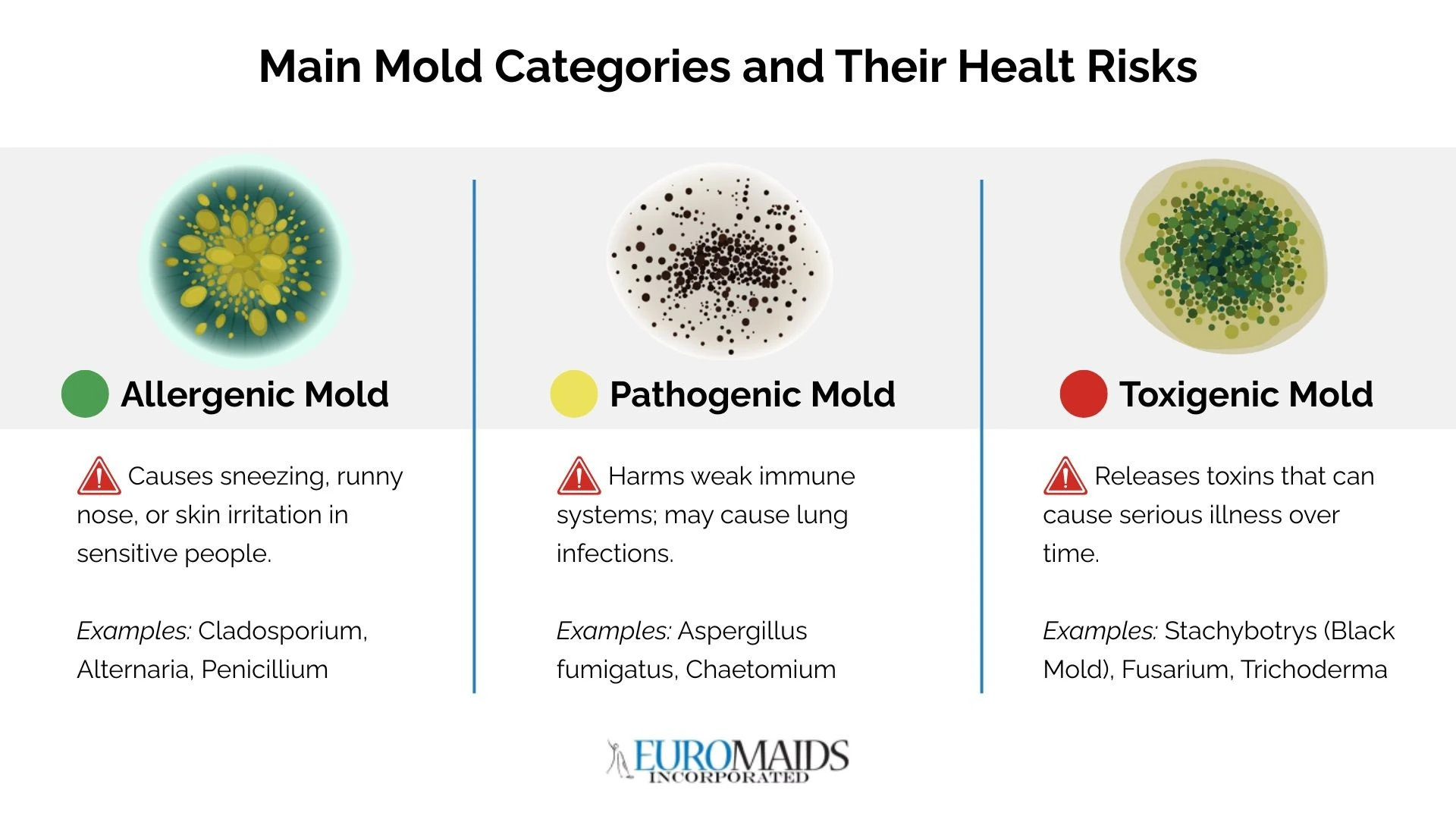
To start with, all mold is classified into three major categories, depending on the degree of harm it may cause:
- Allergenic mold: These are harmless to your health and may cause mild allergies, such as a blocked nose or skin irritation in those sensitive to mold.
- Pathogenic mold: If you have a suppressed, underdeveloped, or compromised immune system, exposure to this mold can pose a significant health risk.
- Toxigenic mold: This mold is incredibly toxic, and professionals should take prompt action to remove it.
The best way to prevent mold from forming is to periodically check areas in your home that produce microclimates conducive to mold growth and ensure there are no surfaces or areas that experience consistent dampness.
Here is a table giving you a preview of the mold types, their features, and health issues they may lead to:
Below, you can read about specific household mold types and see types of mold pictures.
1) Acremonium
Acremonium colonies are white, pink, gray, or orange. If found early, their powdery texture will be moist. Generally, this mold thrives indoors under very wet conditions following flood water damage and is commonly found in moist compact areas like drainpipes, window sealants, humidifiers, and cooling coils.
It's one of the most dangerous house mold types. Its toxicity can cause infection in persons with wound injuries and lead to bone marrow and immune system diseases, as well as brain function impairment. More commonly, mold growth induces hay fever, asthma symptoms, and hypersensitivity pneumonitis.
2) Alternaria
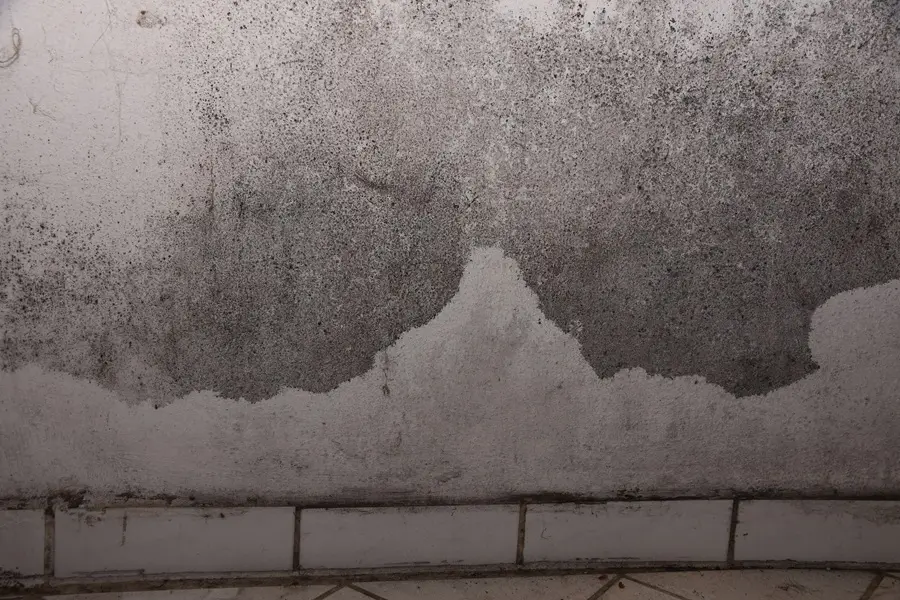
Alternaria is one of the most common types of house mold, with over 250 species. Indoor Alternaria spores usually originate outdoors and multiply in carpets, wallpaper, textiles, window frames, and HVAC systems. Like all mold, it grows in damp and humid areas, reaching maturity in just five days. This type has a velvety texture with dark green or brown hairs.
Those with health problems such as pulmonary diseases, asthma, weak immune systems, and allergies are most vulnerable to this mold. Prolonged exposure to Alternaria has been linked to the onset of asthma in children, while allergies wrought on by its spores are more pronounced in spring and summer. This type of mold habitually lingers in the air on dry, windy days and, when inside, can grow under carpeting and inside walls in some cases.
3) Aspergillus

Aspergillus mold starts off white and transforms to green, black, brown, or yellow as it grows, depending on the species. It has long flask-shaped spores that can form thick layers or walls of mold. It is an allergenic mold, meaning it is most likely to produce allergic reactions such as asthma attacks, lung infections, and respiratory inflammation.
This mold species spreads rapidly in low-nutrient areas like damp carpets, walls, doors, windows, and even pillows. Aspergillus is one of the most common types of house mold found in homes around the world, along with the black and pink mold. It becomes dormant in colder areas but can survive and regrow in warmer weather.
4) Aureobasidium
This mold is common indoors in moist, damp, and humid areas like bathrooms, kitchens, tile grout, behind wallpaper, caulking, window frames, textiles, HVAC units, and on painted and untreated wood. Usually pink, brown, or black, Aureobasidium is flat and smooth and becomes velvety over time.
The primary health risk associated with this mold is its ability to cause eye, skin, and nail infections; it should never be touched with bare skin. Because it is not a primary human pathogen, not everyone exposed to it will get sick. Those at greater risk are people with compromised immune systems, babies, and the elderly.
5) Chaetomium
Chaetomium types of house mold can be found on wallpaper, drywall, door and window trim, paper baseboards, cardboard, carpets, and damp paper, making it a concern for libraries and book and paper archives. It has a cotton-like texture that changes from white to gray to brown and eventually black.
This allergenic and pathogenic mold mostly causes skin and nail infections. If you have Chaetomium in your home, you may have a serious mold problem, as its spores are larger and heavier than other types of mold. Chaetomium is a sign of constant moisture, so be sure to check any leaky water lines and roofs, and damp basements.
6) Cladosporium
Cladosporium is a mold genus with around 220 species, making it one of the more widespread types of house mold. Most of these allergenic mold colonies appear black, brown, and olive green and uniquely grow in both warm and cold conditions. Cladosporium thrives in carpets, upholstery, fabrics, under-the-floorboards, and inside cupboards.
Like Chaetomium, it causes allergic reactions to the skin, eyes, nose, and throat, with symptoms such as skin rashes and lesions, asthma, lung infections, and sinusitis. Even though it's not deadly, it should never be handled directly without protective gear.
7) Fusarium
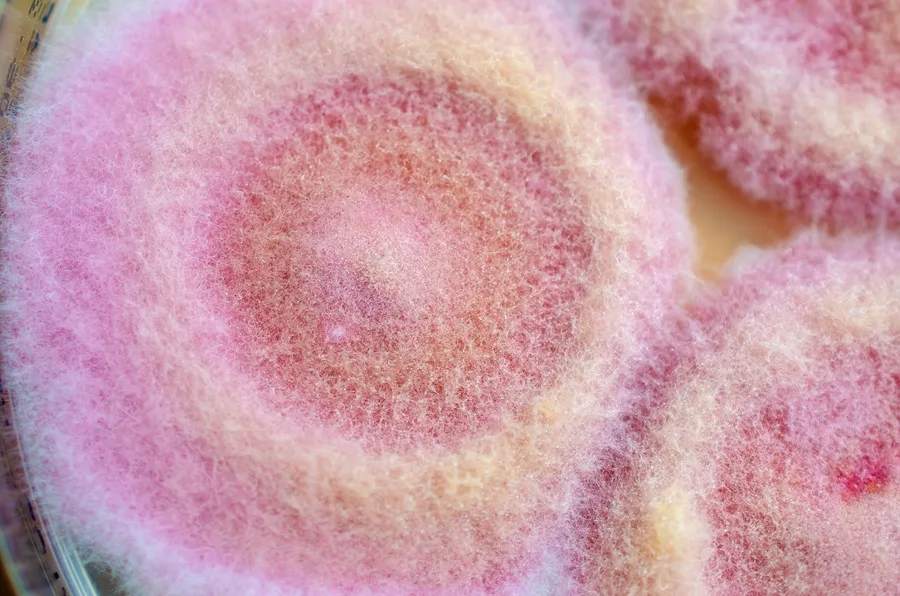
Once inside the home, Fusarium mold spreads rapidly from room to room. If you notice it in one area, it's advisable to examine other areas in your home too. Usually pink, white or reddish-brown, this mold is toxigenic and allergenic, meaning that prolonged exposure may damage the nervous system and potentially lead to hemorrhages and internal bleeding.
This dangerous mold typically grows in carpets, wallpaper, fabric, wood, upholstery, and on any other surfaces that have suffered water damage. Because it requires wet conditions, it's often found in indoor humidifiers and has a flat, wooly, or cotton-like texture.
8) Mucor
Similar to Fusarium, Mucor is a fast-growing mold that's typically white, grey, or cream-beige, with a cottony texture. With over 50 species, this mold grows in thick patches or scattered colonies, feeds on house dust, and can live in carpets, mattresses, and upholstered furniture if moisture levels are high enough.
This strain can trigger respiratory problems and allergic reaction symptoms, including coughing, sneezing, a runny or blocked nose, postnasal drip, a sore throat, itchy eyes, sinus headaches, and skin rashes. In severe cases, it can cause mucormycosis — a fungal infection, which can damage and infect your eyes, nose, sinuses, lungs, and brain. Mucor is most commonly found in buildings that have suffered flood damage and remain damp.
9) Penicillium
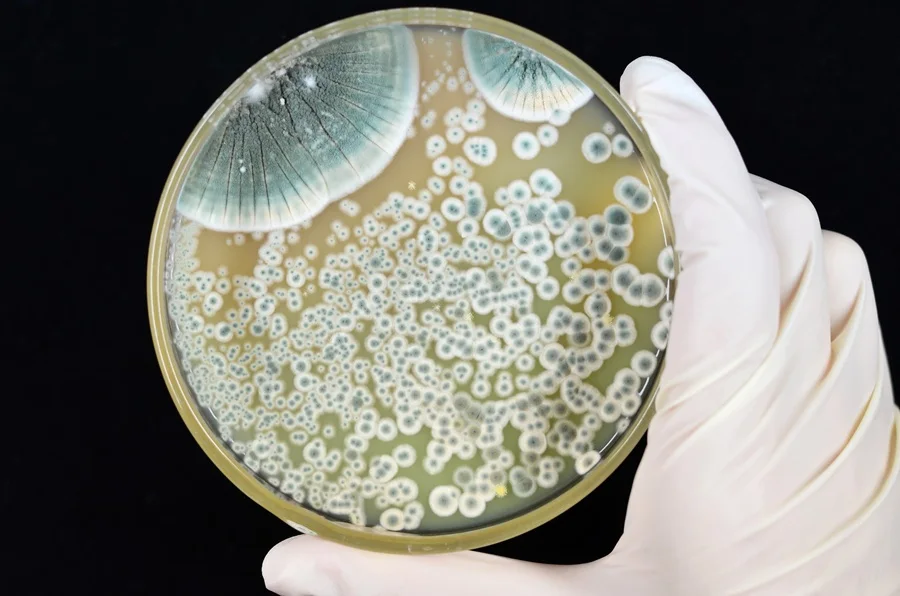
The Penicillium genus contains over 300 species, including Penicillin known for important antibiotic production and food processing capabilities. Usually vivid blue-green or yellow, it does not typically produce serious toxins but remains a concern for immunocompromised individuals. Allergic reactions in the form of respiratory problems and sore throats may occur in some people.
Penicillium is one of the most common indoor molds. It can grow on fabrics, old mattresses, couch cushions, carpets, plywood, and even in the insulation inside walls. Any damp building materials and books, boxes, or wood stored in moist basements are potential hazards.
10) Stachybotrys (Black Mold)
Characterized by black blotches or smears, black mold is unique because of its sticky spores that adhere to surfaces and can remain dormant for many years until reintroduced to a water source. While often touted as one of the most dangerous types of house mold, in most cases, it won't affect or kill an individual.
However, prolonged exposure to black mold may lead to nausea, vomiting, and bleeding in the lungs and nose. This toxic mold favors humid microclimates produced by sweating pipes, underneath sink cabinets, in front-loading washing machines, damp cars, as well as nearby roof leaks and windows with condensation.
11) Trichoderma
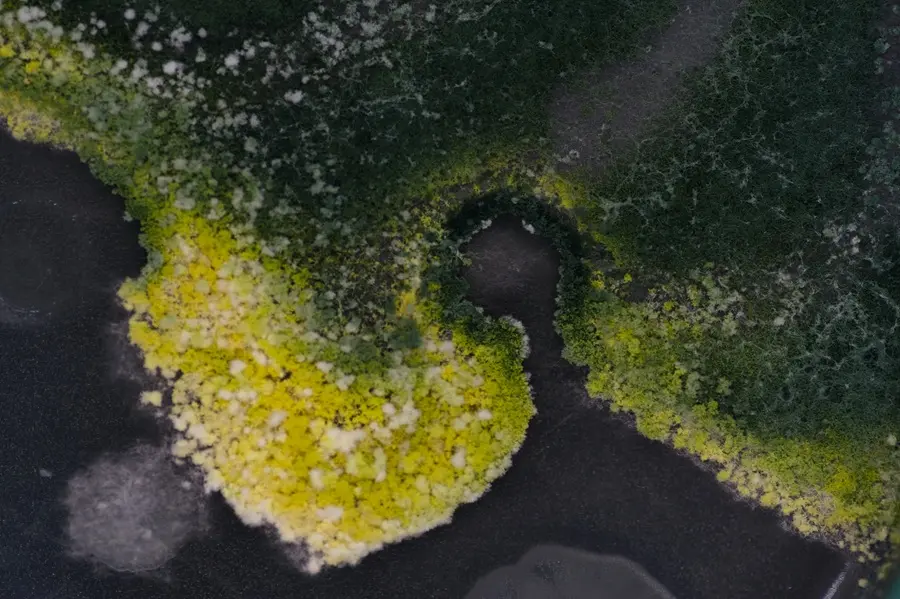
Trichoderma is one of those bathroom mold types that start out as white or yellow and turn gray or dark as the colony matures. It is commonly found in water-saturated wood, gypsum board, paint, HVAC filters, and even in mattresses. Because this mold attacks wood, it can cause rot, damaging the structural integrity of your home, so proper mold removal is crucial.
People with allergies may experience severe reactions, ranging from asthma to persistent coughing and lung infections. If this mold contaminates an air conditioner, it poses a greater health risk, as it's extremely likely to spread all over the house, so be sure to check your HVAC system regularly.
12) Ulocladium
Ulocladium mold is brown, gray, or black and grows in water-damaged buildings, wet carpets, and surfaces. Unlike the other different types of house mold mentioned, it needs large amounts of water to survive, so if present, it's a clear indication of severe water damage.
Textually it's like cotton wool grows rapidly and takes around five days to attain maturity and produce spores. Once inhaled, it may cause allergic reactions like asthma, hay fever, and difficulty breathing. Ulocladium is often found alongside Chaetomium, Fusarium, and Stachybotrys, increasing its potency.
Signs You Have a Mold Problem
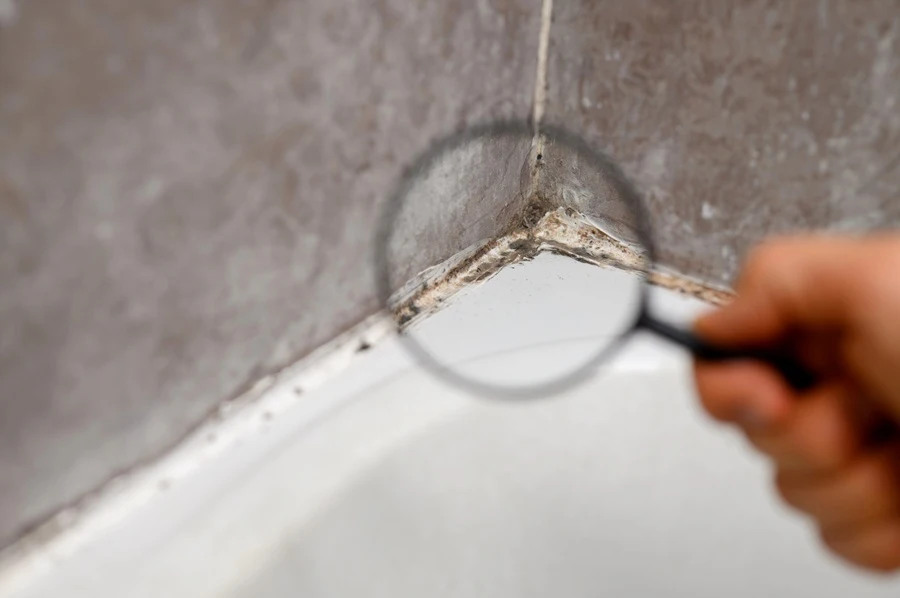
Mold can often grow quietly in corners, under flooring, or behind walls before any visible mold appears. Recognizing early warning signs can help prevent severe reactions and costly repairs.
- Musty odors: Persistent musty smells, especially in damp areas like basements, bathrooms, or kitchens, often indicate hidden growth even when no visible mold is present.
- Visible mold: Dark spots, patches, or fuzzy growth on walls, ceiling tiles, window frames, or other surfaces are clear signs of an active mold colony.
- Water damage signs: Staining, discoloration, or warping of walls, ceilings, or floors may indicate moisture problems that promote mold growth.
- Health symptoms: Increased allergic reactions, respiratory problems, skin irritation, or asthma attacks when at home may suggest exposure to airborne spores.
- Humidity issues: Consistently high indoor humidity levels (above 60%) create ideal conditions for common molds to thrive.
- Recent water events: Flooding, leaks, or other water damage that wasn't properly dried within 24-48 hours create prime conditions for growth.
Early detection can prevent more extensive contamination and protect your family's health while maintaining your home's structural integrity.
How to Get Rid of Mold in Your House
Getting rid of house mold isn’t just about scrubbing. Proper steps ensure that you remove not only visible mold but also reduce future risks. Here's how to tackle mold safely:
#spoilers_start
Assess the Extent of Contamination
Before beginning any mold cleanup, determine whether the affected area is larger than 10 square feet. Small areas can often be handled with DIY methods, while larger infestations require professional mold remediation services. For toxic mold like Stachybotrys, professional help is always recommended regardless of size.
Gather Proper Safety Equipment
Never attempt mold removal without adequate protection. Essential safety gear includes N95 or P100 respirator masks, rubber gloves, protective eyewear, and disposable coveralls. Ensure good ventilation during the process and consider baking soda as a natural cleaning option for small areas.
Isolate the Affected Area
Prevent mold spores from spreading by sealing off the contaminated area with plastic sheeting. Turn off HVAC systems to avoid circulating airborne spores throughout your home. This containment step is crucial for preventing cross-contamination.
Remove and Dispose of Contaminated Materials
Porous materials like drywall, ceiling tiles, carpeting, and insulation that show extensive growth should be removed and disposed of in sealed plastic bags. Non-porous surfaces can be cleaned with appropriate antimicrobial solutions.
Address the Moisture Source
Mold cleanup is only effective if you eliminate the underlying moisture problem. Fix leaks, improve ventilation, and reduce indoor humidity levels to prevent growth of mold. Without addressing moisture issues, mold will likely return.
#spoilers_end
How to Prevent Future Mold Growth
Prevention is easier and cheaper than removal. Here’s how to make sure mold doesn’t come back:
- Control indoor humidity: Keep humidity levels between 30-50% using dehumidifiers, proper ventilation, and air conditioning systems.
- Fix water issues fast: Repair leaks, drips, or damp spots, especially around sink drains, within 24-48 hours. Even minimal moisture can trigger pathogenic molds and allergenic molds.
- Ventilate well: Use fans in kitchens and bathrooms to reduce moisture from cooking and showers.
- Use mold-resistant products: When renovating, choose mold-resistant drywall, paints with mildewcide, and materials designed for high-moisture environments like bathrooms and basements.
- Regular cleaning maintenance: Professional regular cleaning services can help identify and address potential mold issues before they become serious problems.
Implementing these preventive measures creates an environment that naturally discourages mold growth while protecting your family's health and your property investment. Consistent maintenance and vigilance are your best defenses against future mold issues.
Keep Mold at Bay with Expert Cleaning Support
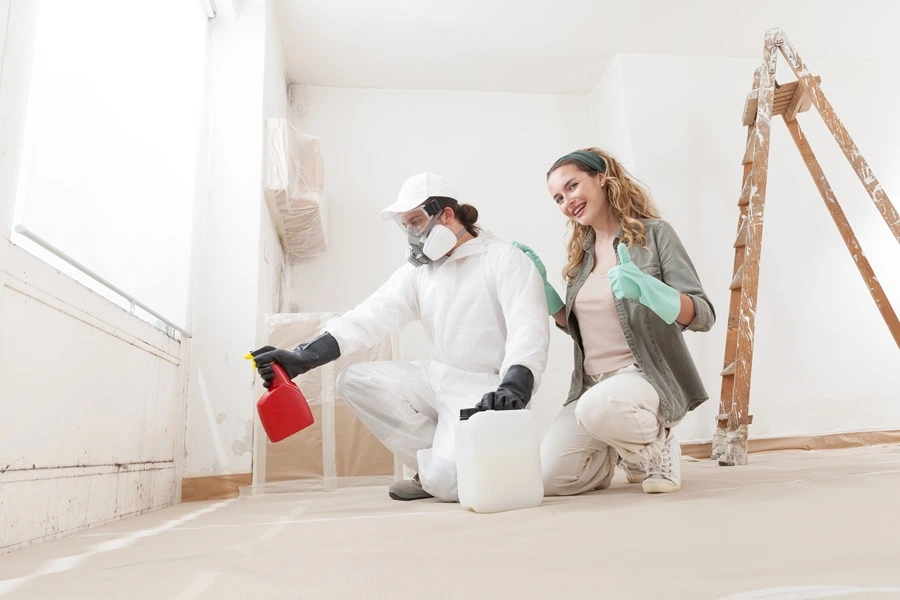
Growing in damp areas, household mold types can produce mycotoxins, resulting in mold allergies and other health problems. Yet, while mold is harmful to humans, it is only after prolonged mold exposure that severe health effects occur, and only in very rare cases is it fatal. It's impossible to eradicate spores as they are part of the natural environment's ecosystem. However, keeping your home clean prevents colonies from forming.
Our professional team at EuroMaids will be happy to clean your space in Naperville, IL to ensure it stays mold-free. Our range of comprehensive cleaning services will make your space look as good as new! Call us at (630) 931-8480 or get your free quote today.

Frequently Asked Questions
Related Posts
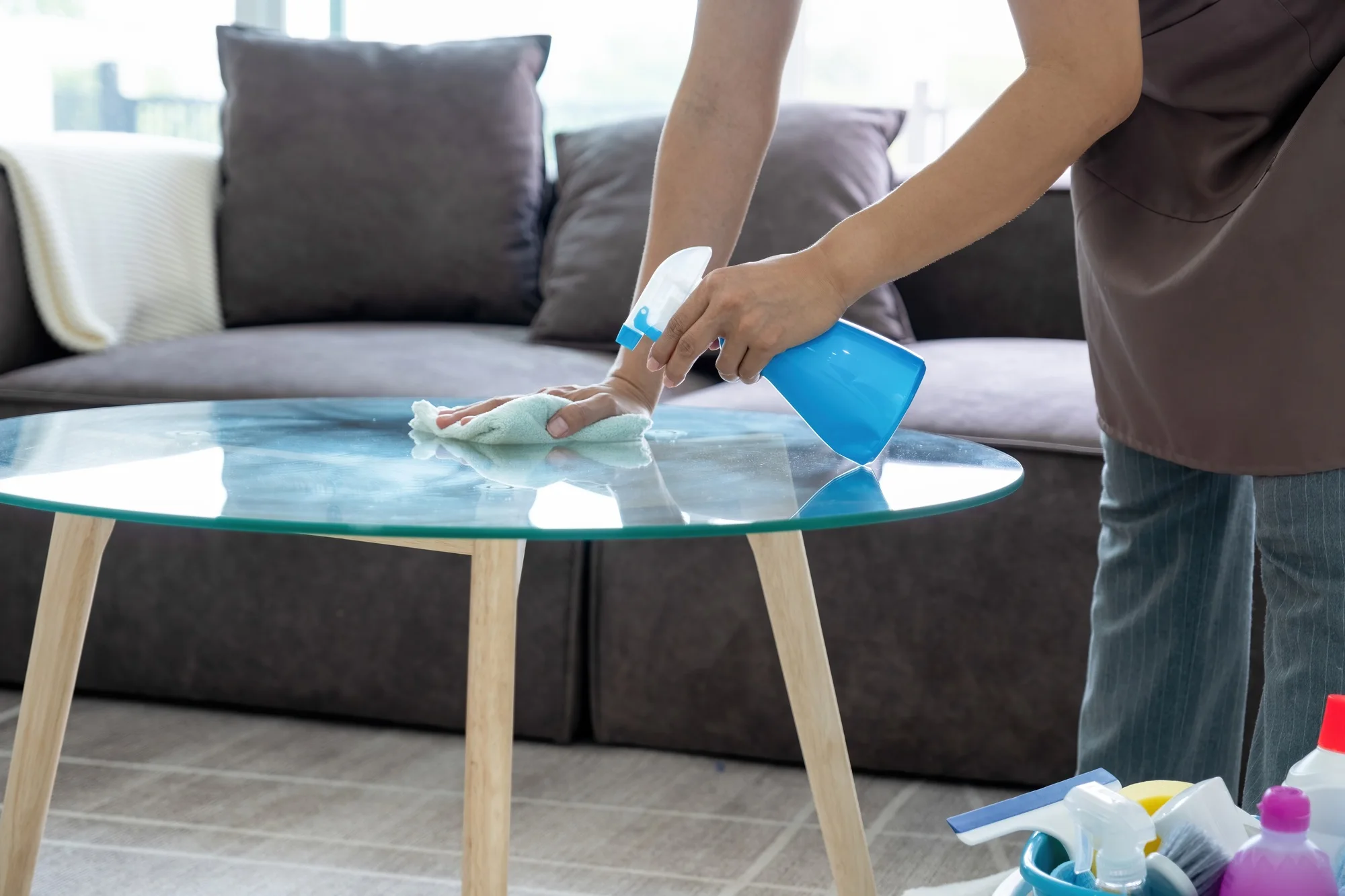
September 12, 2025
November 5, 2025
How to Clean a Glass Table Streak-Free and Keep It Spotless
Learn how to clean glass dining table without streaks in 5 minutes. Expert tips, supplies, and proven techniques for crystal-clear results.
Read More
September 9, 2025
November 5, 2025
Best Way to Clean Construction Dust After Home Renovation: 6-Step Guide
Learn how to clean construction dust from walls, floors & other surfaces safely. Expert 6-step guide with pro tips for dust-free renovation cleanup!
Read More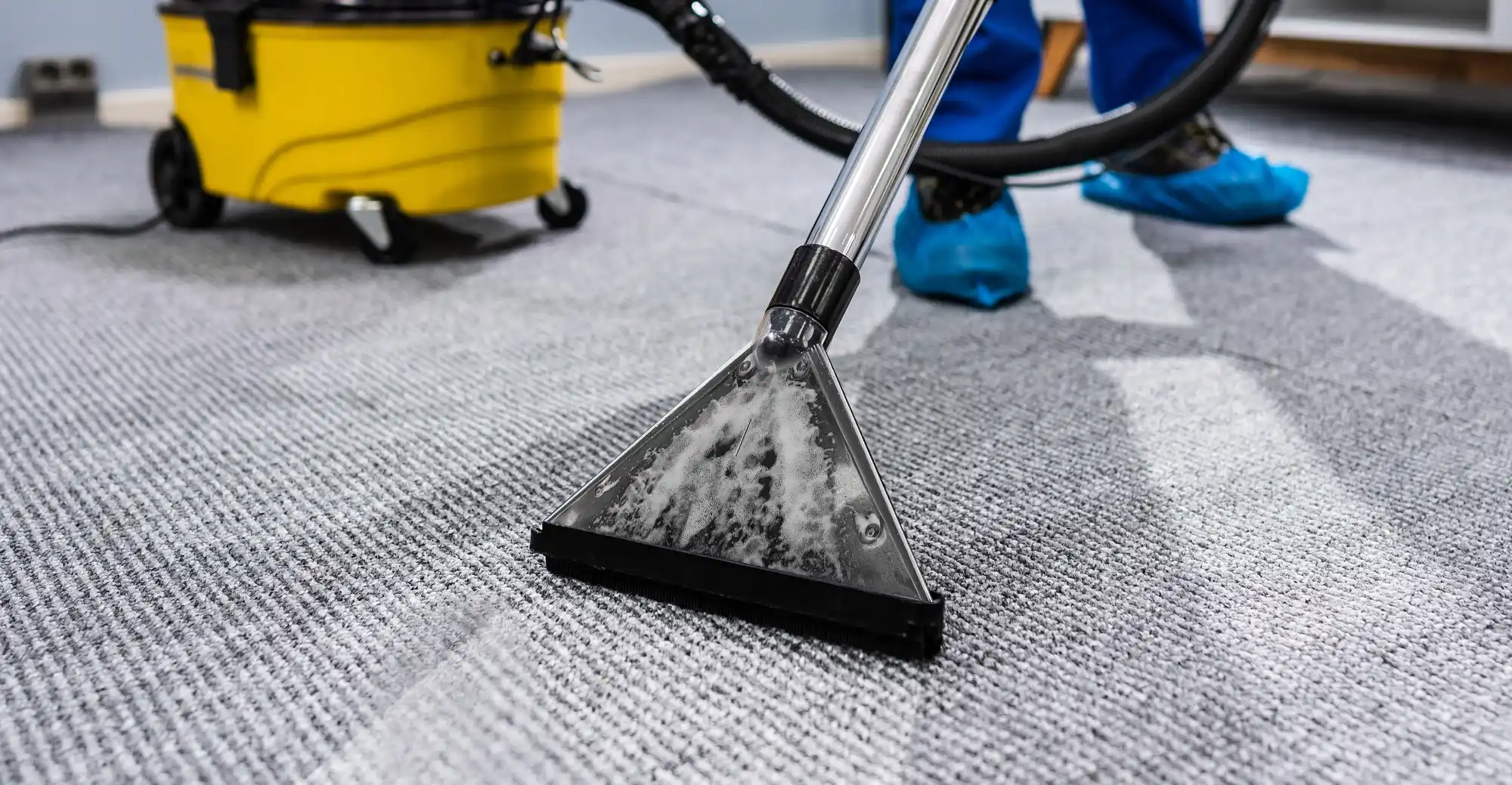
July 22, 2025
November 5, 2025
Average Carpet Cleaning Cost in Naperville, IL: 2025 Complete Guide
Wondering what the average carpet cleaning cost is in Naperville? Learn about pricing models, key cost factors, and tips to save on professional services.
Read More



